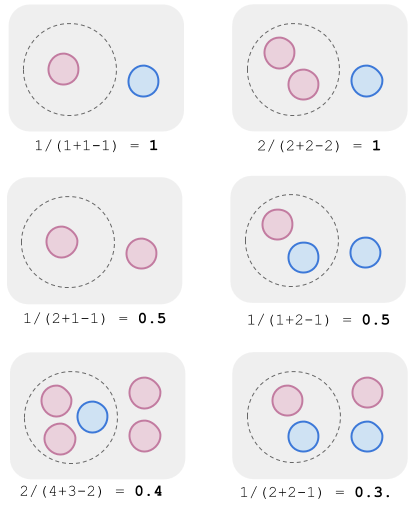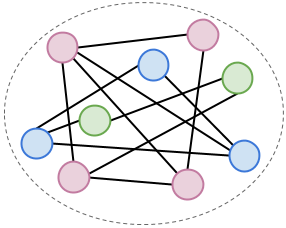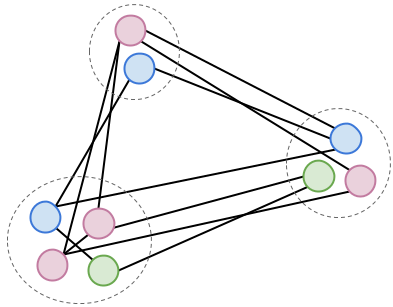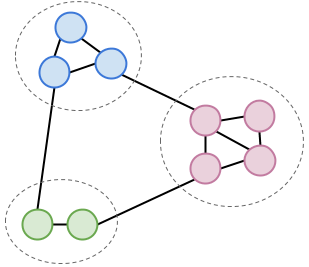

Cohesion and Coupling in OOP
source link: https://hackernoon.com/cohesion-and-coupling-in-oop-cgn31yz
Go to the source link to view the article. You can view the picture content, updated content and better typesetting reading experience. If the link is broken, please click the button below to view the snapshot at that time.

Cohesion and Coupling in OOP

















@ttulkaTomas Tulka
Software engineer and random thoughts generator.
Cohesion done right reduces coupling and complexity of systems.
Let’s start with little definitions:
Cohesion is the degree to which the elements inside a module belong together.
Coupling is the degree of interdependence between software modules.
High cohesion and loose coupling are the most important principles in software engineering. They manifest themselves everywhere from code to team organization.
Cohesion and coupling are tightly related. Why are they so important? Both help us reduce complexity, the true fun killer of software development.
To a lot of people, sadly, the concepts sound too academic and are therefore often poorly understood.
What is cohesion, anyway?
Tough question. The definition is pretty broad and there are several interpretations out there. Not all of them are necessarily wrong, the valid question is: which one is the most beneficial? I use the following definition as I believe it always leads to cohesive components with tight coupling inside and loose coupling outside, which is exactly what we want:
The degree of cohesion of a component by a particular key equals the number of elements cohesive by the key within the component divided by the sum of the total number of elements cohesive by the key in the whole system and the number of elements not cohesive by the key inside the component.
This long definition can be expressed as a simple formula:

Where
ckNI want to emphasize that cohesion doesn’t depend on the number of connections between elements, that’s what coupling is all about. Cohesion is rather about belonging together. However, cohesive components do tend to have a higher degree of coupling within the component, but that’s just a symptom of high cohesion, not the cause.
The definition above might look complicated, but it’s rather quite easy. Let’s illustrate it with some examples. We measure the degree of cohesion by the violet key for the components bordered with a dashed line in the following systems:

Functionality (business) is always the right key to use. Violet and blue can stand for sales and accounting, a product and an invoice, or user registration and ordering.
Notice that my definition may be a bit oversimplified as the boundaries are not always as solid and obvious. This is why business experts must be involved.
Myth busted
Cohesion and coupling are almost always discussed together as they tightly correlate. The relation is sometimes a source of confusion as well, although its understanding is very useful to gain the most for the software system under development.
A typical myth, I often hear people believe in, puts cohesion and coupling in opposition. Practically, they say that “the higher cohesion the tighter coupling”. I’ll show you how wrong this statement is.
This is usually illustrated with an example: Consider the highest possible cohesion of the system where every module is represented by a single line of code (or a single function, an object with a single method, etc.). Such a degree of cohesion will inevitably increase the coupling between modules to the maximum.
As the conclusion is true, there is a small problem in the prerequisite. To find it out, we have to recall the definition of cohesion once again. It talks about belonging together, the strength of relationship of elements, and a common purpose.
What does it mean in practice? In fact, splitting elements that belong together makes cohesion actually lower. So, in the example above, the system really doesn’t have the highest possible cohesion, in the opposite: breaking modules into the smallest possible elements will separate related concepts and will lead to a pretty low cohesion.
The moral here is: Cohesion is not something you can create automatically. Cohesion is discovered in a particular context. That’s why it is so hard for cohesion to be reliably measured. We will discuss this in detail later, stay tuned.
Cohesion and coupling
Let me show you some pictures. In each figure below, there are the very same elements with the very same dependencies. Those are further differently organized. Related domain concepts are represented with the same color:

Elements in the first picture have no explicit boundaries, it’s an example of so-called coincidental cohesion. Such architecture is known as the Big Ball of Mud or the God Object (in OOP code).

The second picture shows a system with three modules and a lot of dependencies between them. Although the modules are highly cohesive, they are cohesive by the wrong key. This happens when code is organized by other than a domain relationship. A typical example is a logical organization of code in the Layered Architecture: just image modules such as controllers, repositories, services, etc. Have you seen these already somewhere? Hell yeah!

The system in the third picture shows the ideal case: correctly organized modules leading to high cohesion and loose coupling. The right key for organization is functionality, in other words, a business domain. The domain defines abstractions with a stable purpose the cohesion is driven upon. By the way, that’s the main idea of the Domain-Driven Design.
Focus on cohesion, not coupling
We exhausted all variants except one: a system with low cohesion and loose coupling. Is it even possible to have such an architecture? Unfortunately, it is, and it’s actually pretty common.
Systems with low cohesion and loose coupling are results of incorrect understanding of the domain and applying purely technical approaches to decouple the modules in an arbitrary way. Interfaces everywhere with no abstraction representing a domain purpose are typical for systems built in this way.
Misuse of interfaces won’t actually reduce coupling anyway, it just moves it into the runtime.
Striving for loose coupling at any cost can (and will) harm cohesion. As loose coupling is driven by high cohesion, we should strive for high cohesion in the first place.
Level of abstraction
Yes, high cohesion doesn’t only make the system easy to understand and change, it also reduces the level of coupling.
How is this even possible? Common sense says that the dependencies don't disappear simply by reorganizing elements. While this is true for the overall system dependencies, high cohesion does reduce dependencies on a higher level of abstraction.
That is, although the absolute amount of dependencies remains the same, the coupling is tackled on different levels of abstraction.
The whole is greater than the sum of the parts. ~ Aristotle
Indeed, we can ignore the interdependencies inside modules getting so a simplified big picture with only three loosely coupled elements:

Neat. As we see, high cohesion actually results in loose coupling!
Talk to me in code!
Pictures are nice, but as software developers, we trust only code, don’t we? Alright, I have some code for you. Consider a simple class for a Book Store (in JavaScript, whatever):
class BookStore {
add(book) { … }
remove(book) { … }
sale(book) { … }
receiptFor(book) { … }
}This class does literally everything. Its cohesion is pretty low and all clients, whatever their needs are, will be coupled to it. It’s an example of a God Object. We can do better:
class Inventory {
add(book) { … }
remove(book) { … }
}
class Sales {
sale(book) { … }
receiptFor(book) { … }
}The
InventorySalesclass Sales {
sale(book) { … }
}
class Accounting {
receiptFor(book) { … }
}But what if our Book Store is just a small family business with one clerk doing sales together with accounting on one old cash desk? We just hit the nail on the head: we can’t really know what the right cohesion key is unless we know the domain really well. True cohesion is defined by the clients. High cohesion is achieved when there’s no way to split the module any further while still satisfying the client’s needs. By the way, this is exactly what the Single Responsibility Principle teaches us.
Conclusion
High cohesion and loose coupling are the main design drivers towards simple system architecture, that is easy to understand, change, and maintain. High cohesion and loose coupling help us reduce accidental complexity and create modules with well-defined boundaries.
- Coupling is about connections, cohesion is about belonging together.
- Cohesion can’t be created automatically, instead it’s discovered in a context.
- Cohesion is defined by the clients.
- True cohesion is domain-driven.
- High cohesion results in loose coupling.
High cohesion is to die for. It enables all others, loose coupling included.
Previously published at https://blog.ttulka.com/how-cohesion-and-coupling-correlate
















Create your free account to unlock your custom reading experience.
Recommend
-
 24
24
Join GitHub today GitHub is home to over 50 million developers working together to host and review code, manage projects, and build software togethe...
-
 7
7
Axiomatic cohesion in HoTT This post is to alert the members of the HoTT community to some exciting recent developments over...
-
 11
11
Beyond Coupling and Cohesion: Strategies For Un-F*cking Yourself Written on August 8, 2021 The terms Loose Coupling and High Cohesion seem to go hand in hand: the two concepts were coined...
-
 11
11
Consistency, Coupling, and Complexity at the Edge Aug 11, 2021 1...
-
 7
7
Kevin SmithIn it for the long haulHigh Cohesion, Loose CouplingKevin Smith · Sep 21, 2021 @ 10:03pm CDT
-
 5
5
'Decentralization Fosters Group Cohesion': Interview with Devendra Singh KhatiDecember 5th 2021 2...
-
 6
6
Cohesion and Coupling in Software with Examples You’re a developer at B...
-
 6
6
SOLID? Nope, just Coupling and Cohesion Skip to main content
-
 7
7
...
-
 9
9
Security is at Odds With Productivity and Team CohesionOctober 18th 2022 new story8
About Joyk
Aggregate valuable and interesting links.
Joyk means Joy of geeK